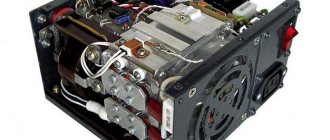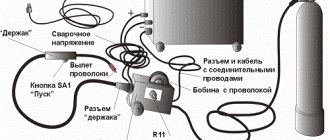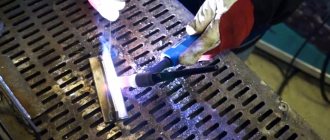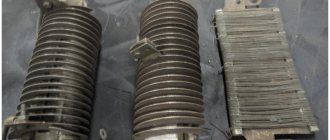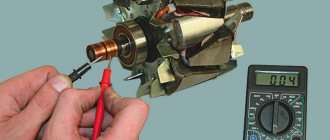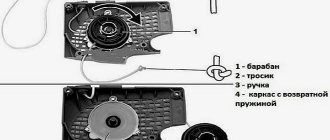Home / Devices
Back
Reading time: 3 min
0
801
Many of you have long appreciated all the advantages of an inverter welding power source or, as it is more often called, a welding inverter.
The presence of this unit on the farm allows you to solve many problems, and its characteristics allow it to be used for all types of welding joints and cutting.
The dimensions and weight of such devices are much smaller than their transformer counterparts, and the quality of welding is no worse.
If we add to this almost 2 times less energy consumption, ease of current adjustment for different types of welding, efficient energy consumption and an efficiency of about 90%, no one will doubt the advantages of these devices.
In this article we will look at one of the most common models of welding inverters - Fubag IN 160 and talk about the most common malfunctions and how to eliminate them.
- Description
- Trouble-shooting
- Starting the renovation
- Automatic shutdown when power is applied
- There is power, but the arc does not ignite
- The device works fine, but the fan does not start
- Finally
Description
The Fubag IN 160 inverter is a compact mobile device. Used for manual arc welding and argon welding. A non-consumable electrode is usually used for welding.
Can be used for welding all types of steels. Fubag IN 160 is easy to transport, lightweight and economical.
Combined with a fairly low price and additional functionality, this is an excellent choice for home craftsmen, regardless of the level of welding skills.
The hot start, arc force and anti-stick functions will help you achieve excellent results, even if your starting settings were not entirely correct. To weld with the Fubag IN 160 inverter, you can use any type of electrode.
Peculiarities
Fubag IN 160 is a budget single-phase inverter. Therefore, it is designed to work with low-carbon metals and cast iron. Although its technical data sheet states that the device can handle galvanized and alloy steel. But in practice, when testing the unit, it turned out that the seam did not meet the declared quality at all.
When German engineers designed the Fubag, their goal was to achieve a low weight welding machine and reduce its dimensions. And they succeeded. Of the entire model range of this brand, the IN 160 model turned out to be the smallest. The company was also able to provide its customers with the most inexpensive device possible, but with a fairly large number of functions and capabilities.
Fubag copes well with standard connections, and also has the ability to perform argon arc welding. It includes a “Hot Start” function that will save the welder from problems with the appearance of an arc. The equipment is also equipped with the “Anti Stick” function, which will ensure the operation of the electrode without problems with its sticking to the metal.
For ease of use of the device, a special display was installed on the panel; it will show the current strength. It also has warning indicators that react to various deviations in the operation of the inverter apparatus. The package includes a special accessory in the form of a protective mask. It was equipped with a liquid crystal screen, it is electronically controlled. The glass of the mask darkens only when a welding arc occurs. This innovative innovation allows you to keep the mask on your head at all times, rather than having to take it off and put it on while welding or not. All electrical equipment is powered by solar panels.
Starting the renovation
Before you begin diagnosing and troubleshooting, you need to prepare the device. First of all, it must be disconnected from the network.
Then install it firmly with the board facing up and provide access to the insides of the device by removing the metal cover screwed with ten screws. To diagnose a problem, in most cases, you will need a multimeter.
Instructions for use
The inverter package includes:
- Holder;
- Power cable;
- Apparatus body;
- Shoulder strap;
- Mask;
- Suitcase for transportation;
- Grounding cable.
As a disadvantage, we can immediately note that the cables are too short (both one and the other). Therefore, welders usually either lengthen them or change them to others. There is also another disadvantage in the form of the lack of a fuse. To solve this problem, you should use an extension cord that can turn off automatically. It is better to set the indicator for RCD (protective shutdown) within 25 A. This will help to avoid burnout of the inverter coils in the event of a surge in the network or overheating of the inverter.
Automatic shutdown when power is applied
The most common problem when working with the Fubag IN 160 inverter is spontaneous shutdown when power is applied. In this case, most likely, the fault should be looked for in the IMS module.
To find out the reason, we need to take a multimeter and set the resistance mode. We measure the resistance between the contacts and ground.
Vague resistance is a sign that the cause should not be sought here. Otherwise, most likely your IMS module needs to be replaced.
To make sure of this, set the multimeter to diode mode and check the diode bridge. If you find a short-circuited diode, your IMS module must be replaced.
Tools
0 votes
+
Vote for!
—
Vote against!
Budget models of welding inverters are characterized by a limited period of uninterrupted operation and a fairly narrow current specification. Therefore, when choosing such a welding machine, you need to weigh the pros and cons. Consider a model from the German manufacturer Fubag IN 160.
Table of contents:
- Description of the welding inverter Fubag IN 160
- Technical characteristics of the welding inverter Fubag IN 160
- Instructions for using the welding inverter Fubag IN 160
Description of the welding inverter Fubag IN 160
- Fubag IN 160 belongs to the budget single-phase inverters. Therefore suitable for working with cast iron and low carbon metals. Domestic technical data sheets indicate that the machine welds galvanized and alloyed steels; in practice, the weld produced is far from ideal. Therefore, it is better not to experiment.
- The main goal of the designers when creating the device was to reduce weight and dimensions. The resulting inverter is the smallest in the entire model range. This is convenient for high-altitude work.
- The manufacturer has tried to provide the most multifunctional device for a minimum amount of money. In addition to classical welding, the possibility of argon arc welding is provided; there is a HOT-START function, which simplifies the formation of an arc. The ANTI STICK function is responsible for ensuring that the electrode does not stick to the metal.
- For ease of operation, a visual display is installed that shows the current strength. There are warning indicators.
- The protective mask is the most interesting accessory in the package. It is equipped with an electronically controlled LCD screen. Darkening occurs only at the moment the arc occurs. Therefore, there is no need to constantly take off and put on the mask. All electronics are powered by solar panels.
- Price ranges from $300 to $350.
Technical characteristics of the welding inverter Fubag IN 160
It’s impossible to draw a conclusion based only on reviews, so let’s take a closer look at the capabilities of the inverter:
- operating voltage - 220 V,
- current strength - 10-160 A,
- uninterrupted operating time 6 minutes at a current of 160 A,
- electrode diameter - 1.6-4 mm,
- dimensions - 42x17x37 cm,
- weight - 4.2 kg, with additional accessories - 6.3 kg,
- transformer idle speed - 75 V,
- protection - IP 21.
If everything is clear with the main characteristics, then we’ll talk about the protection class in more detail. IP marking is a uniform global standard. The first number implies protection from mechanical impact, the second - from water penetration. Considering the sophistication of Fubag IN 160 at a relatively inexpensive cost, it is obvious that the manufacturer had to save money. The second class of mechanical protection means that the main working elements of the inverter are protected from the impact of objects with a diameter of 12 mm and above. The first class of moisture protection means that the device will withstand several vertical drops, therefore you need to work in well-ventilated areas, away from sources of water.
Instructions for using the welding inverter Fubag IN 160
1. Inverter equipment:
- inverter housing,
- holder,
- power cable,
- ground cable,
- carrying strap,
- transport case,
- mask.
It is immediately worth noting that the cables are very short, both power and grounding. Therefore, they will either have to be replaced or a certain equipment upgrade must be carried out. Another serious problem is the lack of a fuse. It will be solved by using an extension cord with automatic shut-off. It is better to install the RCD at 25 A; the standard 16 A will not withstand it and if the device overheats or there is a strong voltage surge, the inverter coils will burn out to the ground.
2. Starting the inverter:
- after assembly, the power cable is connected to the network,
- The device is started by the start button, which also regulates the current strength,
- You only need to turn on the inverter once until all the work is completed; constantly turning the device on and off leads to rapid breakdown of the regulator.
3. Working with inverter:
- select a mode, conventional or argon welding,
- install and secure the appropriate electrode,
- install grounding,
- try the arc,
- make a seam
- let the seam cool down,
- knock off scale.
The average welding current is 115-125 A, in this mode the Fubag IN 160 inverter operates for 10-12 minutes. After this, the device must cool down. In summer it is at least 15 minutes, in winter 5-7 minutes. The device must cool naturally; no fans, air conditioners or even more extravagant means should be used.
There is power, but the arc does not ignite
The next most common problem is with the Fubag IN 160 inverter. Most often it is associated with a lack of contact. To eliminate it, you need to check the screws located immediately after the transformer and the contacts of the plugs.
In most cases, this malfunction is caused by burning of the plug contacts. The problem is solved by cleaning the plug contacts and replacing the screws.
Technical characteristics of Fubag IN 160
Before purchasing an inverter, it is very important to understand what technical characteristics it has, let’s take a closer look:
- device size - 42x17x37 cm;
- current strength - 160 A;
- uptime 6 minutes;
- electrode diameter - up to 4 mm;
- protection system - IP 21;
- unit weight - 4.2 kg;
- idle speed - 75 V;
- operating voltage is 220 V.
Perhaps a novice welder (especially one who is just about to purchase his first inverter) does not fully understand what IP 21 protection means. IP is a single global standard that all welders must adhere to. And the number indicates the degree of protection against mechanical damage and moisture ingress into the device. The protection of this model is not perfect, since the manufacturer’s goal was to save money. But this class means that the inverter parts are protected from objects whose diameter is 12 mm or more. And the unit in the number assumes that the device is insured against several vertical drops, which means that it is better not to subject it to tests, and to work in a place isolated from water.
Common faults
We do not recommend carrying out complex repairs of the Fubag welding inverter (or any other device) at home if you do not have the skills and experience. Unfortunately, many serious breakdowns can only be diagnosed by a professional technician. And a beginner, due to his inexperience, simply will not understand the cause of the malfunction. However, you can still fix some basic problems yourself. Next, we will talk about the most common malfunctions and how to fix them.
Before you start...
Before performing repairs, you need to do a few simple steps. The first and most obvious thing is to disconnect the device from the network. When disassembling the device, it must be placed with the board facing up. The “filling” of the device is hidden behind a metal cover, which is screwed on with 10 screws. You need to unscrew them and remove the cover. When assembling after repair, the device must be assembled in the same sequence. You will also need a multimeter during the work.
When turned on, the device turns off automatically
This is the most common problem. To understand the reason, you need to take a multimeter and set it to resistance mode. Using a multimeter, measure this very resistance between ground and contacts. If the resistance is vague, then everything is fine and the reason lies elsewhere. And if not, then most likely it is necessary to replace the IMS module with a new one.
We also recommend that you additionally check the diode bridge. To do this, set the multimeter to diode mode. Using the device, check the bridge diodes. If you notice that one of the diodes is short-circuited, then the IMS module definitely needs to be replaced with a new one.
The device works, but the arc does not ignite
This is the second most common problem. We recommend checking that the screws that are visible immediately after the transformer are tightened correctly. Also check the plug contacts. Most often, it is the contacts of the plugs that burn, and the arc stops igniting. In this case, you need to clean the plugs and change the screws.
The device functions, but the fan does not work
Most likely the problem is in the fan itself. You need to check its integrity and possibly clean it of dirt. We also recommend that you completely remove the fan and connect it directly to the power supply to check its functionality.
